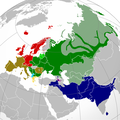Archivo:Indo-European branches map.png

Tamaño de esta previsualización: 599 × 600 píxeles. Otras resoluciones: 240 × 240 píxeles · 479 × 480 píxeles · 767 × 768 píxeles · 1023 × 1024 píxeles · 2045 × 2048 píxeles · 2934 × 2938 píxeles.
Ver la imagen en su resolución original (2934 × 2938 píxeles; tamaño de archivo: 2,16 MB; tipo MIME: image/png)
Historial del archivo
Haz clic sobre una fecha y hora para ver el archivo tal como apareció en ese momento.
| Fecha y hora | Miniatura | Dimensiones | Usuario | Comentario | |
|---|---|---|---|---|---|
| actual | 03:43 26 sep 2022 |  | 2934 × 2938 (2,16 MB) | Alexikoua | minor fixes |
| 15:58 30 mar 2022 |  | 2934 × 2938 (1,74 MB) | Whoop whoop pull up | Whoops, wrong file! | |
| 15:37 30 mar 2022 |  | 2048 × 2048 (980 kB) | Whoop whoop pull up | Misc fixes (Russian minority in Svalbard & Israel, Slovenian in SE Carinthia, Greek in N Epirus, Aromanians/Megleno-Romanians, Swedish essentially extinct in Estonia, etc. | |
| 09:37 22 dic 2021 |  | 2934 × 2938 (1,74 MB) | Ahmet Q. | Reverted to version as of 19:55, 23 August 2021 (UTC)seek consensus for your changes | |
| 20:40 25 nov 2021 |  | 2934 × 2938 (2,16 MB) | Alexikoua | rv elimination of Greek minority in Albania | |
| 19:55 23 ago 2021 |  | 2934 × 2938 (1,74 MB) | Ahmet Q. | Rv false edit summary. Overrepresentation of Greeks in Turkey, Albania and Ukraine. Unexplained removal of Romanian in Serbia. Overall deterioration of the original file. Seek consensus for your changes. | |
| 16:16 7 ago 2021 |  | 2934 × 2938 (2,16 MB) | Demetrios1993 | Addition of Arbereshe linguistic minority in Sicily. Addition of Serbian, Bosnian, and Gorani linguistic minorities in Kosovo. Addition of Greek linguistic minorities in Italy, Albania, Turkey, and Ukraine. Including some other minor corrections. | |
| 17:00 19 nov 2020 |  | 2934 × 2938 (1,74 MB) | Golden | update Armenian | |
| 18:42 31 mar 2018 |  | 1479 × 1479 (574 kB) | Maphobbyist | Removed area that exactly corresponds to the non-Indo European Lezgi linguistic area. | |
| 21:37 6 sep 2016 |  | 1479 × 1479 (620 kB) | Rob984 | Georgia and Azerbaijan aren't majority multilingual. Older generations speak Russian from the Soviet era but now English is taught mainly in place of Russian. More people speak English in Finland, yet that isn't coloured. Also corrections to Celtic are... |
Usos del archivo
Las siguientes páginas usan este archivo:
Uso global del archivo
Las wikis siguientes utilizan este archivo:
- Uso en ast.wikipedia.org
- Uso en ban.wikipedia.org
- Uso en be-tarask.wikipedia.org
- Uso en be.wikipedia.org
- Uso en bg.wikipedia.org
- Uso en cs.wikipedia.org
- Uso en da.wikipedia.org
- Uso en de.wikipedia.org
- Uso en en.wikipedia.org
- Uso en en.wikiversity.org
- Uso en et.wikipedia.org
- Uso en eu.wikipedia.org
- Uso en fa.wikipedia.org
- Uso en fi.wikipedia.org
- Uso en frr.wikipedia.org
- Uso en fr.wikipedia.org
- Uso en gl.wikipedia.org
- Uso en gu.wikipedia.org
- Uso en gv.wikipedia.org
- Uso en hak.wikipedia.org
- Uso en he.wikipedia.org
- Uso en hy.wikipedia.org
- Uso en hyw.wikipedia.org
- Uso en ilo.wikipedia.org
- Uso en incubator.wikimedia.org
- Uso en io.wikipedia.org
- Uso en it.wikipedia.org
- Uso en ja.wikipedia.org
Ver más uso global de este archivo.

